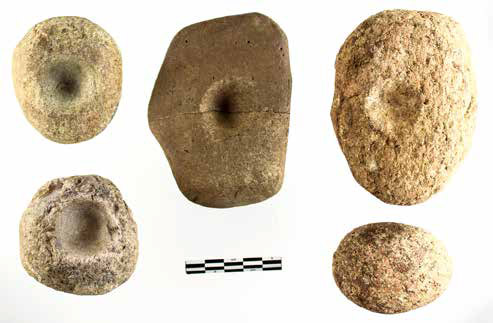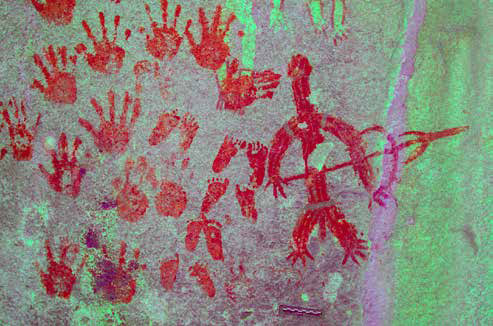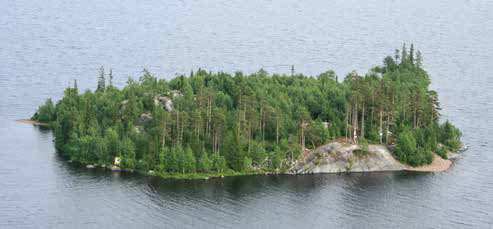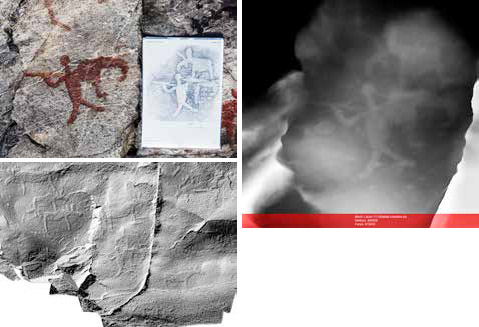Articles: Adoranten 2018
 Amongst the variety of motifs in rock art cup marks are the most common and recurring of them all. In number, they appear alone or more commonly several together, even in hundreds and sometimes combined in motifs of linear or circular style and also appearing in combination with human or animal figures, ships and almost any other rock art motive. They are found in a large variety of contexts, in Denmark mostly known from erratic boulders, on exposed bedrock (on the island of Bornholm only), and on megalithic constructions but otherwise associated with many other constructions and features (Felding 2009, 43-44; Glob 1969; Jørgensen 1972; Matthes 2016; Rostholm 2013). Though being the simplest of the rock art motifs this variety of settings have inspired numerous interpretations including depicting star constellations, “negative” imprint of mounds, symbolizing fire, as cups for offering and more mundanely as numeric count of armies or dead interred in grave chambers (overviews in Glob 1969; Goldhahn 2008b; Lidén 1938). Lately it has been suggested that cup marks are heads and thereby representing people, either specific persons or crowds (Horn 2015). A generally acknowledged interpretation throughout time is that of being a symbol of the life cycles through birth, rebirth and fertility (Felding 2015, 66; Glob 1969), while in some recent research the focus has not been on the actual motif, but on the ritual context the cup marks were made in (Goldhahn 2010, 12; Wahlgren, 2004; Whitley 2001).
Amongst the variety of motifs in rock art cup marks are the most common and recurring of them all. In number, they appear alone or more commonly several together, even in hundreds and sometimes combined in motifs of linear or circular style and also appearing in combination with human or animal figures, ships and almost any other rock art motive. They are found in a large variety of contexts, in Denmark mostly known from erratic boulders, on exposed bedrock (on the island of Bornholm only), and on megalithic constructions but otherwise associated with many other constructions and features (Felding 2009, 43-44; Glob 1969; Jørgensen 1972; Matthes 2016; Rostholm 2013). Though being the simplest of the rock art motifs this variety of settings have inspired numerous interpretations including depicting star constellations, “negative” imprint of mounds, symbolizing fire, as cups for offering and more mundanely as numeric count of armies or dead interred in grave chambers (overviews in Glob 1969; Goldhahn 2008b; Lidén 1938). Lately it has been suggested that cup marks are heads and thereby representing people, either specific persons or crowds (Horn 2015). A generally acknowledged interpretation throughout time is that of being a symbol of the life cycles through birth, rebirth and fertility (Felding 2015, 66; Glob 1969), while in some recent research the focus has not been on the actual motif, but on the ritual context the cup marks were made in (Goldhahn 2010, 12; Wahlgren, 2004; Whitley 2001).
 Cupmarks are found embedded in both bedrock, boulders and smaller stones within different regions of Europe with rock-art tradition. They exist both as single marks, in groups or in relation to figurative rock-art. The appearance in relation with scenes of ritual depictions and megalithic burials had led to an interpretation of religious relation for the cupmarks. As the lack any traits eligible for dating them, they are presumed to follow the chronological span of rock-art in general dating from the Late Neolithic to the end of the bronze age (Horn 2015). In Denmark, cupmarks is the dominating rockcarving, while regional differences can be observed. Bornholm stands out with the highest number of figurative carvings, following the tradition from Norway and Sweden with exploitation of natural bedrock surfaces. For the remaining Danish area, figurative rock art occurs to a higher degree in the eastern parts, while cupmarks is predominant in the western parts (Felding 2010).
The smaller cupmarked pocket-stones stands out among the rock-art tradition as an autonomous group, consisting of smaller stones with 1 to 11 cupmarks, and distributed across the current Danish area. The cupmarks is usually smaller than those on bedrock or larger stones. A common trait is the lack of contextual information which means that they are presumed to be chronologically related to the same time frame as cup-marks in general (Glob 1969: 128-9). A combination of the strange composition of the stones, lacking context and focus on cupmarks on rock art has probably led to low level of research into these stones.
Cupmarks are found embedded in both bedrock, boulders and smaller stones within different regions of Europe with rock-art tradition. They exist both as single marks, in groups or in relation to figurative rock-art. The appearance in relation with scenes of ritual depictions and megalithic burials had led to an interpretation of religious relation for the cupmarks. As the lack any traits eligible for dating them, they are presumed to follow the chronological span of rock-art in general dating from the Late Neolithic to the end of the bronze age (Horn 2015). In Denmark, cupmarks is the dominating rockcarving, while regional differences can be observed. Bornholm stands out with the highest number of figurative carvings, following the tradition from Norway and Sweden with exploitation of natural bedrock surfaces. For the remaining Danish area, figurative rock art occurs to a higher degree in the eastern parts, while cupmarks is predominant in the western parts (Felding 2010).
The smaller cupmarked pocket-stones stands out among the rock-art tradition as an autonomous group, consisting of smaller stones with 1 to 11 cupmarks, and distributed across the current Danish area. The cupmarks is usually smaller than those on bedrock or larger stones. A common trait is the lack of contextual information which means that they are presumed to be chronologically related to the same time frame as cup-marks in general (Glob 1969: 128-9). A combination of the strange composition of the stones, lacking context and focus on cupmarks on rock art has probably led to low level of research into these stones.
 Red, white and more rarely yellow footprints are a particular motif of Central Indian rock art that we have found in several painted sites, even if it is not –by far- one of the most frequent themes represented. We shall particularly concentrate on the State of Chhattisgarh where we could study it in different areas.
Red, white and more rarely yellow footprints are a particular motif of Central Indian rock art that we have found in several painted sites, even if it is not –by far- one of the most frequent themes represented. We shall particularly concentrate on the State of Chhattisgarh where we could study it in different areas.
If footprint representations are common the world over, in India, and particularly in the region under study, age-old traditions of footprint making are still alive in many places. In certain parts of the State, auspicious prints made on the floor of the house entrance and sometimes on the wall inside the house represent the feet of Lakshmi, the Goddess of Wealth. More to the point, we have collected evidence of footprint making in very recent times -the past decades- in rock art sites of the Chhattisgarh State. We have systematically looked for information in the local tribes and from local people about the reasons why they made that particular gesture, on which occasions and who did it, both concerning the rock art and the prints on the floors of houses. We are certainly not proposing to “explain” the rock art and its complex details in the light of present-day practices. The long persistence of ancient traditions in Central India, however, as well as the continuance of ritual practices in painted shelters, including making footprints and/or footprint representations on the walls, enable us to better understand some of the reasons that may have prompted their authors in the rock art of the region under study.
 The Kanozero Lake located at the southern part of the Kola Peninsula (Murmansk region, Russia). In 1997 the first petroglyphs were discovered at the lake on Kamenniy Island, which were mainly made in the Neolithic and Bronze Age. Up to now 20 panels with petroglyphs are recorded and total number of recorded rock carvings is close to 1500 images. In this article a short geographical and historical overview of the area and history of discovery and investigation of the Kanozero petroglyphs is given.
On July 5, 1997, Yuri Ivanov found the first petroglyphs on a rocky island of the Kanozero Lake (the Umba River system on the Kola Peninsula). Within the next few years it became obvious that a large petroglyphic complex was located at the Kanozero Lake area. According to data of the Kola archeological expedition the total number recorded petroglyphs is more than 1.200 on 18 panels (Kolpakov, Shumkin 2012: 16). Last year’s research (2017-2018) with use of photogrammetry method revealed two more panels with rock carvings and a significant number of unrecorded earlier petroglyphs on known panels.
The Kanozero Lake located at the southern part of the Kola Peninsula (Murmansk region, Russia). In 1997 the first petroglyphs were discovered at the lake on Kamenniy Island, which were mainly made in the Neolithic and Bronze Age. Up to now 20 panels with petroglyphs are recorded and total number of recorded rock carvings is close to 1500 images. In this article a short geographical and historical overview of the area and history of discovery and investigation of the Kanozero petroglyphs is given.
On July 5, 1997, Yuri Ivanov found the first petroglyphs on a rocky island of the Kanozero Lake (the Umba River system on the Kola Peninsula). Within the next few years it became obvious that a large petroglyphic complex was located at the Kanozero Lake area. According to data of the Kola archeological expedition the total number recorded petroglyphs is more than 1.200 on 18 panels (Kolpakov, Shumkin 2012: 16). Last year’s research (2017-2018) with use of photogrammetry method revealed two more panels with rock carvings and a significant number of unrecorded earlier petroglyphs on known panels.
 The petroglyphs at Nämforsen in Ångermanland, Sweden are a masterpiece among the Scandinavian rocks carvings, with its massive imagery of elks, ships and humans. The magnificent situation in the midst of the plangent rapids reinforces the northern accent. Although clear southern elements such as weapons, footprints and circle-crosses occur, the relatively low frequency of these phenomena seemingly has not affected the overall interpretation and dating of the site to any significant extent.
However, some ship types differ significantly from the typically northern ones. In addition, finds from the nearby settlements, at Ställverket and at Råinget, clearly demonstrates that their main occupation period was the Bronze Age, a time when it has been argued that the practice of making rock carvings had ceased (Baudou 1993, Forsberg 1993, c.f. Käck 2001, George 2001, Käck 2009). Although this scenario could be possible, the explanation still seems a little strange. Spontaneously, it should have been the other way around: that the use to make rock carvings should have peaked when the settlements did. It has previously been discussed whether this contradictory situation reflects a prehistoric reality or resulting from an interpretative discourse assuming that the carvings demonstrate an actual difference, pictorial, chronological and social, between northern hunting and southern farming cultures (Bertilsson 2015 and 2017) However, as all the new information from the last decade’s extensive archaeological excavations has been brought to light a more nuanced picture has begun to emerge (cf. Nykvist 2007).
The petroglyphs at Nämforsen in Ångermanland, Sweden are a masterpiece among the Scandinavian rocks carvings, with its massive imagery of elks, ships and humans. The magnificent situation in the midst of the plangent rapids reinforces the northern accent. Although clear southern elements such as weapons, footprints and circle-crosses occur, the relatively low frequency of these phenomena seemingly has not affected the overall interpretation and dating of the site to any significant extent.
However, some ship types differ significantly from the typically northern ones. In addition, finds from the nearby settlements, at Ställverket and at Råinget, clearly demonstrates that their main occupation period was the Bronze Age, a time when it has been argued that the practice of making rock carvings had ceased (Baudou 1993, Forsberg 1993, c.f. Käck 2001, George 2001, Käck 2009). Although this scenario could be possible, the explanation still seems a little strange. Spontaneously, it should have been the other way around: that the use to make rock carvings should have peaked when the settlements did. It has previously been discussed whether this contradictory situation reflects a prehistoric reality or resulting from an interpretative discourse assuming that the carvings demonstrate an actual difference, pictorial, chronological and social, between northern hunting and southern farming cultures (Bertilsson 2015 and 2017) However, as all the new information from the last decade’s extensive archaeological excavations has been brought to light a more nuanced picture has begun to emerge (cf. Nykvist 2007).
 Recent discoveries in the chemical and isotopic sourcing of metals and ancient DNA have transformed our understanding of the Nordic Bronze Age in two key ways. First, we find that Scandinavia and the Iberian Peninsula were in contact within a system of long-distance exchange of Baltic amber and Iberian copper. Second, by the Early Bronze Age, mass migrations emanating from the Pontic-Caspian steppe had reached both regions, probably bringing Indo-European languages with them. In the light of these discoveries, we launched a research project in 2019 — ‘Rock art, Atlantic Europe, Words & Warriors (RAW)’ — based at the University of Gothenburg and funded by the Swedish Research Council (Vetenskapsrådet). The RAW project undertakes an extensive programme of scanning and documentation to enable detailed comparison of the strikingly similar iconography of Scandinavian rock art and Iberian ‘warrior’ stelae. A linguistic aspect of this cross-disciplinary project is to re-examine the inherited word stock shared by Celtic and Germanic, but absent from the other Indo-European languages, exploring how these words might throw light onto the world of meaning of Bronze rock art and the people who made it. This paper presents this linguistic aspect of the RAW project and some preliminary findings.
Recent discoveries in the chemical and isotopic sourcing of metals and ancient DNA have transformed our understanding of the Nordic Bronze Age in two key ways. First, we find that Scandinavia and the Iberian Peninsula were in contact within a system of long-distance exchange of Baltic amber and Iberian copper. Second, by the Early Bronze Age, mass migrations emanating from the Pontic-Caspian steppe had reached both regions, probably bringing Indo-European languages with them. In the light of these discoveries, we launched a research project in 2019 — ‘Rock art, Atlantic Europe, Words & Warriors (RAW)’ — based at the University of Gothenburg and funded by the Swedish Research Council (Vetenskapsrådet). The RAW project undertakes an extensive programme of scanning and documentation to enable detailed comparison of the strikingly similar iconography of Scandinavian rock art and Iberian ‘warrior’ stelae. A linguistic aspect of this cross-disciplinary project is to re-examine the inherited word stock shared by Celtic and Germanic, but absent from the other Indo-European languages, exploring how these words might throw light onto the world of meaning of Bronze rock art and the people who made it. This paper presents this linguistic aspect of the RAW project and some preliminary findings.
 This article discusses the application of high performance computing (HPC) to the remote processing of high quality image based models of rock carvings in the field, using Agisoft PhotoScan / Metashape Professional software1. Most work to date has been carried out on the Danish e- Infrastructure Collaboration National High Performance Computer Abacus 2.0, hosted as part of the eScience Centre at The University of Southern Denmark (SDU). More recently, the author has been testing the cloud processing facility available within Metashape Professional, that utilizes Amazon Web Services (AWS) EC2 HPC cluster. This work forms part of the fieldwork component of the author’s PhD project at Aarhus University, Denmark, investigating regionality in Southern Tradition rock art through a programme of extensive documentation of rock carvings, principally on the island of Bornholm, Denmark, and also parts of Central and Southern Norway and Western Sweden. The successful deployment of this technology as part of a programme of surface based documentation breaks new ground in the fields of rock art research, archaeology, and high performance computing in equal measure. Therefore, the workflow discussed in the following pages has wide ranging implications for a number of disciplines.
This article discusses the application of high performance computing (HPC) to the remote processing of high quality image based models of rock carvings in the field, using Agisoft PhotoScan / Metashape Professional software1. Most work to date has been carried out on the Danish e- Infrastructure Collaboration National High Performance Computer Abacus 2.0, hosted as part of the eScience Centre at The University of Southern Denmark (SDU). More recently, the author has been testing the cloud processing facility available within Metashape Professional, that utilizes Amazon Web Services (AWS) EC2 HPC cluster. This work forms part of the fieldwork component of the author’s PhD project at Aarhus University, Denmark, investigating regionality in Southern Tradition rock art through a programme of extensive documentation of rock carvings, principally on the island of Bornholm, Denmark, and also parts of Central and Southern Norway and Western Sweden. The successful deployment of this technology as part of a programme of surface based documentation breaks new ground in the fields of rock art research, archaeology, and high performance computing in equal measure. Therefore, the workflow discussed in the following pages has wide ranging implications for a number of disciplines. Cup-marks and the contexts in which they are found is the selected theme of this issue of Adoranten. The cup-mark is perhaps the most universal worldwide symbol. It is known from many cultures in all parts of the world, but it is far from certain that this worldwide symbol had the same meaning or function in different periods. The evidence to date indicates that it has been attributed to different qualities, due to changing beliefs over prehistoric time. Also, it has undergone transformations in response to subsequent superstitions and legends, as well as having been subject to influence from Christianity.
Cup-marks have been given various names in various cultures, including ‘cup stone’, ‘cup hollow’, ‘cup symbol’, ‘butter stone’, ‘elf grinding mill’, ‘sacrifice stone’, ‘altar stone’, ‘skittle alley’, ‘map of stars’ and ‘fertility symbol’. Some are very objective, like cup hollow (from the Danish skålformede fordybning), whilst others indicate associations with various beings and actions. Many of the names connect cup-marks with elves, dwarves and various other-worldly beings (the so-called underjordiske). Others seem to refer to actions, what one might call rituals, carried out at the sites. Some of these have religious connotations, like ‘altar stone’, whereas names like ‘butter stone’ and ‘sacrifice stone’ refer to a practice whereby materials or artefacts were placed in the depressions. This activity can be linked to fertility rites and a wider suite of non-Christian religious practices. These in turn gave rise to names such as ‘fertility symbol’ and names of individual stones like ‘The Devil’s Bowling Alley’ (Fandens Keglebane, for example in Nexo, East Bornholm, Denmark).
Cup-marks and the contexts in which they are found is the selected theme of this issue of Adoranten. The cup-mark is perhaps the most universal worldwide symbol. It is known from many cultures in all parts of the world, but it is far from certain that this worldwide symbol had the same meaning or function in different periods. The evidence to date indicates that it has been attributed to different qualities, due to changing beliefs over prehistoric time. Also, it has undergone transformations in response to subsequent superstitions and legends, as well as having been subject to influence from Christianity.
Cup-marks have been given various names in various cultures, including ‘cup stone’, ‘cup hollow’, ‘cup symbol’, ‘butter stone’, ‘elf grinding mill’, ‘sacrifice stone’, ‘altar stone’, ‘skittle alley’, ‘map of stars’ and ‘fertility symbol’. Some are very objective, like cup hollow (from the Danish skålformede fordybning), whilst others indicate associations with various beings and actions. Many of the names connect cup-marks with elves, dwarves and various other-worldly beings (the so-called underjordiske). Others seem to refer to actions, what one might call rituals, carried out at the sites. Some of these have religious connotations, like ‘altar stone’, whereas names like ‘butter stone’ and ‘sacrifice stone’ refer to a practice whereby materials or artefacts were placed in the depressions. This activity can be linked to fertility rites and a wider suite of non-Christian religious practices. These in turn gave rise to names such as ‘fertility symbol’ and names of individual stones like ‘The Devil’s Bowling Alley’ (Fandens Keglebane, for example in Nexo, East Bornholm, Denmark).

|


